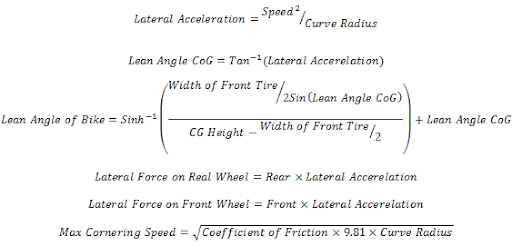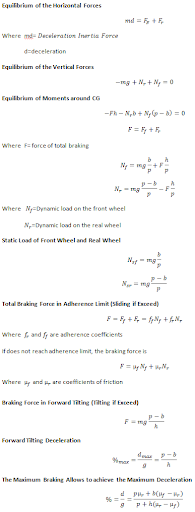1.1 Forces Acting On Motorcycle
The forces acting on a motorcycle can be divided into two; that are the external forces and the internal forces.
The external forces are:

- Gravity (Green): This force is minuscule compared to all the other forces involved and can be ignored.
- Ground reaction: The vertical component (red) counteracts with gravity, braking and accelerating. The horizontal component (yellow) counteracts with propulsive force, braking forces and turning forces.
- Turning forces (Orange): Basically referred to as centrifugal force.
- Gyroscopic forces (Magenta): Forces acting on rotating parts such as wheels, engine and transmission.
- Aerodynamic forces (Blue): Drag forces caused by atmosphere. It is the largest force resisting forward motion.
The internal forces are:
- By rider: The rider can apply torques between the steering mechanism (front fork, handlebars, front wheel, etc.) and rear frame, and between the rider and the rear frame. In other words, the internal force may exist when the rider adds an extra weight on only one side (left or right) of the motorcycle.
- By friction: Exists between any parts that move against each other.
1.2 Balance
The self-stability of a motorcycle is generated by a combination of several effects that depend on the forward speed, mass distribution (CoG) and the geometry (trail) of the bike.
- Forward Speed/Inertia Effect: The products mass multiplied by the velocity of a body gives the quantity of motion of the body. The greater this value is, the less influential external forces will have on the trajectory. (More Information)
- Center of Mass Location: The closer to front wheel the center of mass of the combined bike and rider, the less the front wheel has to move laterally in order to maintain balance. Conversely, the closer to the rear wheel the center of mass is located, the more front wheel lateral movement or bike forward motion will be required to regain balance.
- Trail: Trail is the distance that the front wheel ground contact point trails behind the steering axis ground contact point. The more trail a motorcycle has, the more stable it feels but it becomes harder to steer. (More Information)

- Gyroscopic Effect: In any event, gyroscopic forces play little role in leaning the bike over, though they do help set the steering angle. The appealing notion that gyroscopic forces are central to a bike’s behavior, often repeated in papers and textbooks are incorrect. (More Information)
1.3 Turning
Steering a motorcycle or bicycle is counterintuitive; to turn right, you must steer left initially, and vice versa. You can execute this initially counter-directed turn by turning the handlebars explicitly (called counter-steering) or by throwing your hips to the side. (More Information)
Contrary to popular belief, the height of Centre of Gravity play very little role in determining lean angle. (More Information)
1.4 Braking
For a basic motorcycle, brakes can be applied to both the front and back wheel. Although it is actually more preferable to apply brakes only to the back wheel for stability purposes. If brake force is applied too much or solely on the front wheel alone, the possibility of the rear wheel skidding is very high.
- Front Wheel Braking: Less preferred but produces quite a significant amount of deceleration (about 0.5g). This is because most of the weight of the bike and rider transfers forward onto the front wheel when the brakes are applied. The weight transfer that takes place under braking on a motorcycle pushes the front wheel onto the ground and makes it grip very well. (Source)
- Rear Wheel Braking: More preferred but produces very little amount of deceleration (about 0.1g).
1.5 Vibrations
In addition to the road surface, vibrations in a motorcycle can be caused by the engine and wheels, if unbalanced. Manufacturers employ a variety of technologies to reduce or damp these vibrations, such as engine balance shafts, rubber engine mounts, and tire weights. The problems that vibration causes have also spawned an industry of after-market parts and systems designed to reduce it. Add-ons include handlebar weights, isolated foot pegs, and engine counterweights.
At high speeds, motorcycles and their riders may also experience aerodynamic flutter or buffeting. This can be abated by changing the air flow over key parts, such as the windshield.
1.6 Degrees of Freedom
There are two sources. The first source states that there are seven (7) degrees of freedom which includes:
- forward motion of the motorcycle(translational)
- rolling motion(rotational)
- handlebar rotation(rotational)
- longitudinal slippage of the front wheel (braking)(translational)
- longitudinal slippage of the rear wheel thrust or braking)(translational)
- lateral slippage of the front wheel(translational)
- lateral slippage of the rear wheel(translational)
This only applies IF both the wheels of the motorcycle are always in contact with the road. The second source on the other hand, states that a motorcycle has eleven (11) degrees of freedom which includes:
- x motion of frame(translational)
- y motion of frame(translational)
- z motion of frame(translational)
- yaw angle(rotational)
- roll angle(rotational)
- pitch angle(rotational)
- steering angle(rotational)
- rear suspension deflection(translational)
- front suspension deflection(translational)
- rear wheel angle spin(rotational)
- front wheel angle spin(rotational)

2.1 Static Vertical Load

2.2 Turn Conditions
There are two equations used to calculate the turn conditions that we found off the internet. The first one is very basic and have been taught before in Statics.

The second equation is slightly more complex and takes in the minute effect of centre of gravity and width of tires.

2.3 Centre of Gravity

(Source)
2.4 Braking


(Source)
3.1 Simulators Around the World
Driving simulation has been used for many years in research studies on driving behavior for auto¬mobiles, trucks, and other vehicles. There are many simulators available for these vehicles at various levels of cost, complexity, and fidelity. There are two important aspects of fidelity or realism of the simulator: cue fidelity and dynamics and control fidelity.
- Cue fidelity pertains to the display the operator interacts with, including visual, motion, and sound. If they are suitably designed, motorcycle simulators can more readily achieve higher cue fidelity regarding their ability to simulate the riding task faithfully, in comparison with automobile simulators.
- Dynamics and control fidelity pertain to the simulated vehicle response to various kinds of operator inputs. For a motorcycle, the vehicle response and operator inputs are considerably more complex than for a car. For a motorcycle, the responses include motorcycle roll, yaw, and pitch angles and rates, and forward and lateral translation. The operator inputs include steer torque and steer angle; lateral and fore-aft upper-body lean angle; and braking, throttle, and gearshift control inputs.
Purposes of a motorcycle simulator:
- Research; A motorcycle simulator is capable of giving researchers valuable information on rider and road safety, motorcycle design and motorcycle engineering. This unique system will allow engineers to study aspects of motorcycle ergonomics and rider human factors -- a relatively new research area. This covers all aspects of motorcycling, from motorcycle design and rider equipment to rider behavior and competence and road safety.
- Training (Civilian); Besides, motorcycle simulator is an important training aid. For total beginners it enables the student to become familiar with the controls of either an automatic scooter or geared motorcycle. Later, by using highly challenging and realistic scenarios it teaches the student the importance of excellent observational skills, and prints out the resultant score. Later still it can be used to track the improvement in skill levels in all circumstances. The simulator is begin used as part of the training in all Basic training courses and as required both at other levels and for remedial training.
- Training (Military); Motorcycle simulation is often used in the training of military personnel. This usually occurs when it is prohibitively expensive or simply too dangerous to allow trainees to use the real equipment in the real world. In such situations they will spend time learning valuable lessons in a "safe" virtual environment. Often the convenience is to permit mistakes during training for a safety-critical system.
3.2 EF-Bike Motorcycle Simulator

EF-Bike showing three hi-resolution 42" plasma monitors, force-feedback steering, operational instrument cluster and motion base.

EF-Bike visuals showing hi-resolution graphics with integrated motion base dynamics.

EF-Bike graphical representation of the motion base movement dynamics.
For more details on the technical aspects of the EF-Bike, refer to this article.
3.3 PC-based Motorcycle Safety Training Device

For more details on the technical aspects of the training device, refer to this article.
3.4 The Moris Motorcycle Simulator

The motorcycle hub standing on actuators that will simulate movement.
For more details on the technical aspects of the training device, refer to this article.
After we did the background study for motorcycle, more specifically motorcycle dynamic, we have a better understanding of the science and physics behind motorcycle motion. Few of our misconceptions about riding motorcycle also have been corrected after this study. For example, counter-steering does exist when we are making a turning. This would help us a lot in designing our own motorcycle simulator.
The objective of our motorcycle simulator is academic; it is used for student to understand the motorcycle engineering and dynamic. We have decided to use Honda C70 cub as our motorcycle, since budget is one of our consideration in this project and C70 is much popularized in Malaysia.
The degree of freedom of a motorcycle is 11 as stated above. Hence, our main goal of next research is to go further detail with every motion and calculations behind each degree of freedom. Besides, we also will find out types of actuators, decoders or sensors that are suitable in actuating or measuring those signals.



